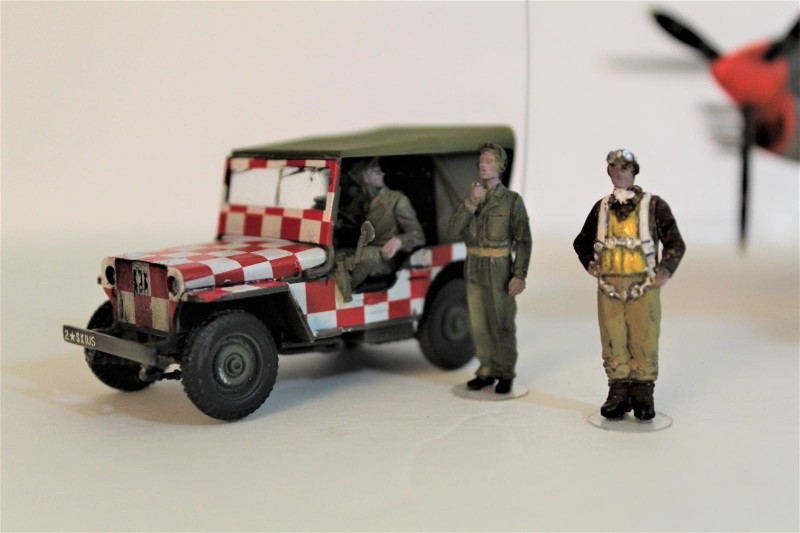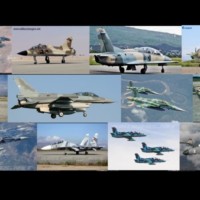Hobbyboss 1/48 P-38L Lightning & Hasegawa 1/48 “Follow Me” jeep
Solsala Italy...part of the Foggia complex of about 25 airfields within a 25 mile radius of Foggia on the west coast of Italy...Ramitelli was among them
The p-38 lightning was America's darling fighter on Dec 7 1941...it was like look what we've got for you...Doolittle called it the "sweetest plane in the sky"...and it lived up to it's hype in the Pacific theatre as it shot down more Japanese planes than any other even ambushing Admiral Yamamoto the mastermind of Pearl Harbor...perhaps it should have been called the Avenger...it's twin engine gave it long legs over vast expanses of ocean and it was perfect for the steamy jungle air and rain of the South Pacific.MacArthur asked for 50 P-38's and General Kenny's 5th AF turned the tide in the Pacific.
However when it reached the green fields Europe it didn't fair nearly as well...Oh course some Pacific pilots claimed the Euro front pilots weren't as good but the reality was the frigid temperatures at 30,000 feet turned it into a slug ...especially against German pilots and machines used to that theatre...many critics say the P-38 was far too complex and hard to learn on a novice pilot entering combat with very few hours in the type, maybe as few as 25...
The long-range P-38 Lightning made many important contributions to the allied victory in Europe, including being the first allied fighter to escort 8 AF bombers to Berlin. In the Fall of 1943, the Lightning staved off defeat for the 8th in the daylight bombing campaign of Germany, the bleak Schweinfurt period
Robin Olds whom i once had the great privilege to meet said “I loved the P-38 but I got those kills in spite of the airplane, not because of it ..The fact is the P-38 Lightning was too much airplane for a new kid and a full-time job for even a mature and experienced fighter pilot. Our enemies had difficulty defeating the P-38 but, as much as we gloried in it, we were defeating ourselves with this airplane."... but you have to remember at the beginning of WW11 the American Air Force had no idea how to even fight another air force.
To start off the Lightning was probably the most frigid of all allied fighters as no allied fighters had any heat to speak of...in the p-38 you sat in a gondola between the two engines so you didn't even get the benefit of engine heat blowback...there were ineffective ducts but they froze...the electric long johns didn't work for them, probably burned them so they had no choice..many a pilot had to be helped out of the cockpit and propped up by ground crew after 8 hours to Berlin and back.
The P-38's combination of Allison inline engines and GE turbocharger turned out to be dangerously unreliable in the very cold (-60F) high-altitude conditions over Northern Europe in the winter. Sometimes the turbo control would get stuck at the wrong level - giving different boost on the two engines and thus mismatched thrust; if you didn't change the pitch, throttle, and boost settings in the right sequence, the engine might completely blow itself up...but his nose-mounted 20mm cannon and four .50-caliber machine guns were shredders in the hands of a pilot who knew and loved the type.The P-38 performed usefully but suffered from a number of problems. Its Allison engines consistently threw rods, swallowed valves and fouled plugs, while their intercoolers often ruptured under sustained high boost and turbocharger regulators froze, sometimes causing deadly failures...pilots referred to it as the Allison time bomb...the P-38j model's enlarged radiators were trouble-prone. and Improperly blended British fuel exacerbated the problems: Anti-knock lead compounds separated in the Allison's induction system at extreme low temperatures. This could cause detonation and rapid engine failure, especially at the high power settings in combat...many of the P-38s assigned to escort missions were forced to abort and return to base. Most of the aborts were related to engines coming apart in flight due to intercoolers that chilled the fuel/air mixture too much. Radiators that lowered engine temps below normal operating minimums. Oil coolers that could congeal the oil to sludge. problems that could have been fixed at the ground crew level but they were not.”
Col. Rau wrote with trepidation...when a kid is bounced He must turn, he must increase power and get rid of those external tanks and get on his main [fuel tank]... “So, he reaches down and turns two stiff, difficult gas petcocks to main, turns on his drop tank switches, presses his release button, puts the mixture to auto rich (two separate and clumsy operations), increases his RPM, increases his manifold pressure, turns on his gun heater switch (which he must feel for and cannot possibly see), turns on his combat switch and the gunsight bulb which has been turned off to preserve it, then he is ready to fight.” ...“At this point, he has probably been shot down,” ... “or he has done one of several things wrong. Most common error is to push the throttles wide open before increasing RPM. This causes detonation and subsequent engine failure.,,,
The US Air Force rushed two P-38 combat groups to England and they racked up their first aerial victories...as one pilot wrote “We were arrayed against the Luftwaffe and they were facing us head-on,” and one of the pilots turbocharger regulators froze, causing catastrophic failure...We weren't winning
With an 1100 mile radius or 2400 miles with tanks and engine feathering she ruled the Pacific expanses...and with time to bring herself up to a fighting airplane she was a formidable opponent in warm climates at lower altitudes...a marvelous tropical aircraft but overly complicated for pilot or mechanic... nonetheless a great plane in the hands of the right professionals...unlike the mustang and spitfire she just couldn't quite git-r-done in Europe even though they managed to knock down 1800 enemy fighters with a loss of 450 P-38's over Europe and she turned into a formidable ground attack, pathfinder and photo recce aircraft as well as fulfilling the early night fighter roll
Lt. Philipp.E. Torvea 15th AF 8 kills...Sweet Sue/ Nellie Ann...silver star for gallantry against the enemy and distinguished flying cross for extraordinary achievement in combat...R.I.P.
--- pic18 not found ---





















Nice work Bob !
thank you David...I am very grateful
Outstanding work, Mr. Mack...really nice job on both.
thank you for your comment Craig
Nice model and a really interesting background story. It's really great to get an understanding of the pro's and con's of an aircraft or vehicle or ship.
wonderful compliment Ulf...thank you
Great job, Bob! It’s nice to see a P-38 for a change.
I am so glad you enjoyed it John...i thank you
Terrific build(s), Bob. It’s a great looking Lightning with a very engaging write up. Nicely painted, finished, and presented.
‘Liked’ a lot.
thank you for enriching this site with your time David
Ha. Thanks for that, but you got it the wrong way round, it’s the site that enriches me, Bob.
Look forward to seeing more of your projects.
your a beacon in this ocean David
Very nice Bob! Great looking -38, and love the write-up. Well done all the way around.
thank you very much Greg...your energy is always so positive
Excellent work bob!
i appreciate that very much Dale...thank you
What a wonderful posting Bob ! Everything about it is perfect...the model, the story, just everything. Sadly you don't see too many P-38's completed when compared to the other types. It's such a beautiful plane...
"liked"
80% of the guys in flight school wanted to fly them Louis...one of the prettiest and ominous, almost evil like the phantom and the stuka...thank you
A real great build, Bob!
thank you so much Bob
Very nice builds! I have heard the P-38 was a SOB to pilot, but never quite understood why. Thanks for the story of The Pacific Lightnings compared to European ones!
very sophisticated Ted...in the hands of Jimmy Doolittle it was gold ...but to the novice pilot and mechanic an enigma...reminded me of the movie "the dawn patrol"and thank you sir
Just wonderful Bob! Great write up & great build. Thanks for sharing your talents with the group.
thank you sir for that marvelous comment Matt
Actually, the P-38's problems were only in England, and are thought to be due to the use of British AvGas. P-51s also had problems in England encountered nowhere else with spark plugs, with build-up on the plugs from the gasoline. Use of British plugs solved that.
So far as the P-38s in Italy were concerned, all was well and the 1st, 14th and 82nd FGs operating in the Italian Theater with 15th AF had no problems. This was likely due to the fact they used good American 100 octane. The 15th AF P-38s were as successful as their Pacific counterparts (who were also using US avgas). In both cases, the P-38s didn't fly at 30,000 feet as in the ETO.
The P-38 was definitely a flying handful for a low-time pilot. The cockpit wasn't the most ergonomic, and there were important items like fuel management that took the pilot's eyes off the instrument panel. This workload overload is considered to be the reason Jeff Ethell crashed and died in the P-38 he was flying - low-time (in the '38) pilot, got distracted with other work when he should have been focused on altitude and airspeed since he was at low speed. Steve Hinton told me it's the most difficult warbird he's flown; the contra-rotating props turn into the "bad" engine in an engine-out situation, not what you want.
Nice work on this model.
thank you Tom...as with you it's still my favorite aircraft and a lot of pilots loved it...it really reminded me of "the dawn patrol" where flynn becomes the whip and niven begs him not to send his tenderfoot brother to his death which he must...also these guys were actually coming back with frostbite...yeager said you got a little heat from the p-51, darned little as the relief tubes froze...i worked outside for 35 years and when the temp got below 20 F it was ignorant and below 0 almost took your functions away...can't imagine minus 60...they needed oil heaters like in north dakota not oil coolers...whole different game but the gas was a mess..and.it all could have been avoided pretty easily
I have to add my high regards for the P-38 and the pilots who flew them.
It wasn't the perfect aircraft - few - if any - are, but the Lightning was a real workhorse.
And it looks sooooo cool! Bob. yours is an excellent example and many thanks for sharing it with us!
thank you Jeff...i love the 38 too...looking at it just gives me a warm feeling in the gut...and what guys like bong mcguire lynch and lindberg did with it was stunning...it was almost sexy and all that fire power made it a truly great plane...good to hear from you by the way
This is a joy too see, you have done a nice job on that model Bob.
The sheen looks nice and the job is so clean and sharp. This is a 1/48 scale model, it would be interesting and worthwhile too see what you can do on a 1/32 scale.
thank you very much Ray...i do have the trumpy with lots of accessories...resin wheels, metal guns and a complete big ed set and bombshell decals...ummm
I just stumbled across your Nice build! Wow! May i ask what decals you used?